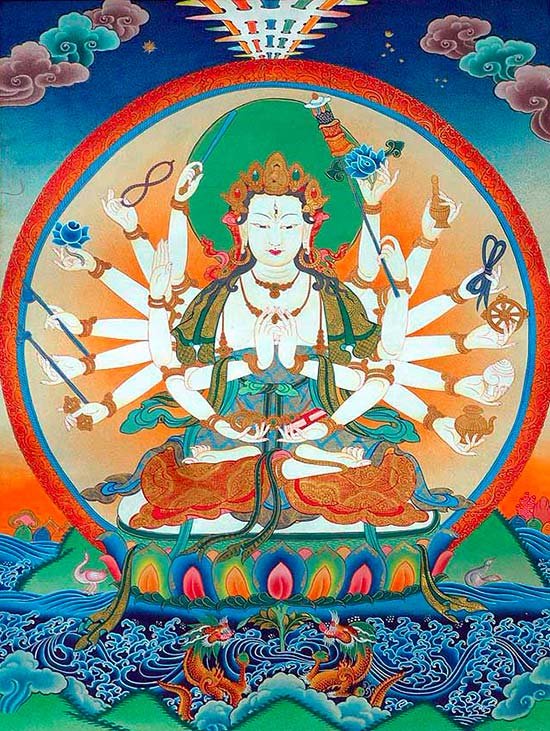Maha Prajnaparamita Sastra
by Gelongma Karma Migme Chödrön | 2001 | 941,039 words
This page describes “exertion and the other virtues” as written by Nagarjuna in his Maha-prajnaparamita-sastra (lit. “the treatise on the great virtue of wisdom”) in the 2nd century. This book, written in five volumes, represents an encyclopedia on Buddhism as well as a commentary on the Pancavimsatisahasrika Prajnaparamita.
Part 3 - Exertion and the other virtues
1. Moreover, the exertion of the bodhisattva is practiced diligently from lifetime to lifetime: the mind of the bodhisattva never draws back from seeking wealth and treasures to give to beings; if he himself possesses goods, he never ceases to give them all away.
2. Moreover, the bodhisattva observes the precepts (śīla) energetically; whether they are great (mahat) or lesser (kṣudra), he takes them all, he keeps them all without transgressing or violating them. If he happens to miss a precept, be it small as a hair, he confesses at once and hides nothing.
3. Moreover, the bodhisattva diligently cultivates patience (kṣānti). Whether one strikes him with a knife or a stick, whether one harms him or insults him, whether he is covered with veneration (satkāra) or worship (pūjā), he endures all of it and remains indifferent and detached. In the face of the profound Dharma (gambhīradharma)[1] that his mind is unable to probe, he ignores doubt and hesitation.
4. Furthermore, the bodhisattva cultivates the four trances (dhyāna) with exertion and special attention. He can dwell there, keep them and thus obtain the five superknowledges (abhijñā), the four boundless ones (read sseu wou liang sin: paramāṇa citta), the [eight] liberations (vimokṣa), the spheres of mastery (abhibhvāyatana) [p. 969F, l. 6] and the ten spheres of totality (kṛtsnāyatana). Provided with these qualities (guṇa), he obtains the four foundations of mindfulness (smṛtypasthāna) and all the samādhis of the bodhisattva, such as the vision of the Buddhas, etc.
5. Finally the bodhisattva’s exertion is without drawing back in seeking the Dharma (dharmaparyeṣaṇā); he uses body and mind to pay homage to Dharma teachers (dharmācārya); he increases offerings, alms and gifts without fail or relapse. He dedicates his life to study and discussion of the Dharma. During the first, second and last watch of the night, he contemplates (manasikāroti), meditates (cintayati), calculates (pramāṇayati) and speculates (vikalpayati); he looks for causes and conditions (hetupratyaya); he distinguishes between identity and difference (sāmānyaviśeṣa); he seeks to understand the true nature (satyalakṣaṇa) and to establish, for all dharmas, their specific nature (svalakṣaṇa), their general nature (anyalakṣaṇa), the general characteristic (sāmānyalakṣaṇa), the specific characteristic (bhinnalakṣaṇa), the unique characteristic (ekalakṣaṇa), the nature of existence (bhāvalakṣaṇa), the nature of non-existence (abhāvalakṣaṇa) and the essential nature (tathatālakṣaṇa). The absence of decrease (asaṃlayana) or of relapse (avivarana) of the Buddhas and bodhisattvas constitutes the exertion of the bodhisattva. For all these reasons, he can produce and realize the many good dharmas and this is the “virtue of exertion”. For the meaning of the word virtue (pāramitā), see what has been said above. In addition, the exertion of the bodhisattva is the only one to be called [178a] virtue of exertion (vīryapāramitā); the exertion of other people does not merit the name of virtue.
Question. – What is meant by perfection of exertion (vīryaparipūri)?
Answer. – When the bodhisattva, in his body of birth (janmakāya) and his essential body (dharmadhātukāya),[2] unites all the qualities (guṇa), there is the perfection of the virtue of exertion (vīryapāramitāparipūri). For the meaning of paripūri, see what has been said above: “In bodily and vocal exertion, the bodhisattva does not draw back.” (p. 927F)
Footnotes and references:
[1]:
The gambhīradharmas have been defined above, Traité, I, p. 337–338F.
[2]:
As we have seen above, Fa sing, for Kumārajīva, gives dharmadhātu and not dharmatā.
